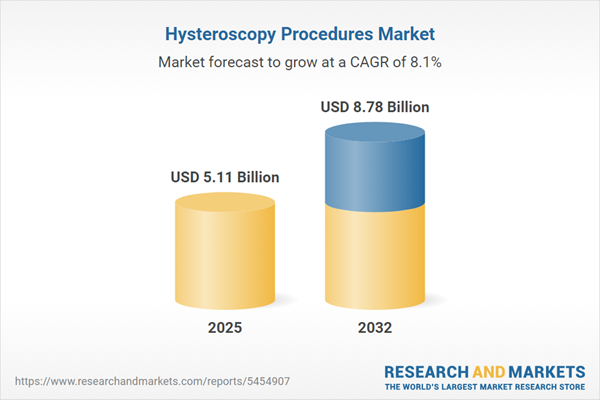Speak directly to the analyst to clarify any post sales queries you may have.
As healthcare systems respond to complex operational challenges and evolving care requirements, the hysteroscopy procedures market is becoming a focal point for innovation and efficiency in surgical gynecology. Senior executives and decision-makers have an opportunity to drive value by adopting strategic solutions and fostering patient-centered care within a transformative industry landscape.
Market Snapshot: Hysteroscopy Procedures Market Overview
The global hysteroscopy procedures market is estimated at USD 4.72 billion for 2024, with an anticipated compound annual growth rate (CAGR) of 8.06% extending through 2032. Growth is propelled by the expanding use of minimally invasive gynecology, increased demand for single-use instruments, and evolving reimbursement strategies. Advances in hysteroscopy device technologies and the trend toward outpatient care settings continue to shape market strategies for providers and suppliers seeking operational improvements and reliable patient outcomes.
Scope & Segmentation: Hysteroscopy Procedures Market Analysis
- Procedure Types: Covers both diagnostic and operative hysteroscopy. Emphasizes process improvements and the need for strategic allocation of clinical resources to support best-in-class patient outcomes.
- Device Types: Encompasses single-use and reusable systems. Focuses on infection control, cost efficiency, and scalability to suit different healthcare facility profiles.
- Technological Advancements: Integrates flexible fiberoptic, video-enabled, and rigid device systems. These innovations bring enhanced procedural accuracy and streamline workflows for more consistent results.
- End User Categories: Evaluates the varied operational demands of hospitals, ambulatory surgical centers, and clinics. Facility type influences procurement processes and schedules for technology rollouts.
- Clinical Applications: Includes use for adhesiolysis, endometrial ablation, and intrauterine growth management. Device versatility supports broad clinical service portfolios while ensuring adaptability.
- Procedure Settings: Assesses transition to outpatient and low-acuity environments. This shift improves accessibility and matches evolving patient and provider preferences without compromising care quality.
- Component Integration: Highlights seamless coordination of hysteroscopes, accessory tools, and procedural media. Integration supports standardization and more predictable care pathways.
- Geographic Coverage: Addresses dynamics across Americas, Europe, Middle East and Africa, and Asia-Pacific. Considers regional regulations, systemic maturity, and unique practice patterns shaping adoption rates and workflows.
- Key Countries: Examines leading and emerging markets, with an emphasis on procurement trends and technology adoption in major economies such as the United States, Canada, Europe, Asia-Pacific, Latin America, and Middle East and Africa.
- Leading Companies: Offers detailed competitive landscape analysis, profiling approaches from Olympus Corporation, KARL STORZ SE & Co. KG, Richard Wolf GmbH, Stryker Corporation, Smith & Nephew plc, CONMED Corporation, CooperSurgical, Inc., Boston Scientific Corporation, Johnson & Johnson, and Ambu A/S.
Key Takeaways: Strategic Insights for Senior Decision-Makers
- Consistency in minimally invasive procedures relies on workflow integration, supporting standardized care across hospitals and ambulatory environments.
- Intelligent and video-enabled imaging technologies enhance decision-making and help deliver safer outcomes in routine and advanced gynecological interventions.
- Modular and single-use device solutions are improving infection prevention and keeping organizations aligned with emerging compliance standards.
- Western markets favor fully integrated hysteroscopy platforms for optimized care delivery, while Asia-Pacific healthcare facilities often prioritize adaptable solutions for broader scalability.
- Supply chain continuity and resilience receive greater attention due to persistent regional and global disruptions, prompting a focus on risk-adjusted procurement strategies.
- Market evolution requires proactive planning for regulatory and reimbursement changes, with technology investments designed to balance cost control and future readiness.
Tariff Impact: Navigating Regulatory and Trade Shifts
Recent U.S. tariffs on hysteroscopy devices have influenced the sourcing and logistics strategies of healthcare providers. Executives are reevaluating supply chains, with heightened interest in regional supplier networks and domestic manufacturing to mitigate cross-border vulnerabilities. As regulations and budget constraints intensify, agile procurement and robust risk management are critical for sustaining reliable operations and supply stability.
Methodology & Data Sources
This report brings together insights from gynecology clinicians, procurement professionals, and technical experts. Information is drawn from regulatory agencies, validated industry databases, and peer-reviewed publications, providing a balanced and authoritative perspective tailored to market realities.
Why This Report Matters
- Enables executive benchmarking for hysteroscopy solutions and supports strategic product portfolio decisions amid rapid technology and regulatory change.
- Delivers actionable, evidence-based insights tailored to compliance needs and distinct regional market dynamics.
- Supports procurement and risk teams in developing agile, resilient supply chains and targeted risk mitigation approaches for evolving industry conditions.
Conclusion
This analysis empowers executive leaders with the insights and frameworks needed to navigate the evolving hysteroscopy procedures market, supporting continued innovation and operational excellence in patient-centric environments.
Additional Product Information:
- Purchase of this report includes 1 year online access with quarterly updates.
- This report can be updated on request. Please contact our Customer Experience team using the Ask a Question widget on our website.
Table of Contents
3. Executive Summary
4. Market Overview
7. Cumulative Impact of Artificial Intelligence 2025
Companies Mentioned
The companies profiled in this Hysteroscopy Procedures market report include:- Olympus Corporation
- KARL STORZ SE & Co. KG
- Richard Wolf GmbH
- Stryker Corporation
- Smith & Nephew plc
- CONMED Corporation
- CooperSurgical, Inc.
- Boston Scientific Corporation
- Johnson & Johnson
- Ambu A/S
Table Information
| Report Attribute | Details |
|---|---|
| No. of Pages | 187 |
| Published | October 2025 |
| Forecast Period | 2025 - 2032 |
| Estimated Market Value ( USD | $ 5.11 Billion |
| Forecasted Market Value ( USD | $ 8.78 Billion |
| Compound Annual Growth Rate | 8.0% |
| Regions Covered | Global |
| No. of Companies Mentioned | 11 |









